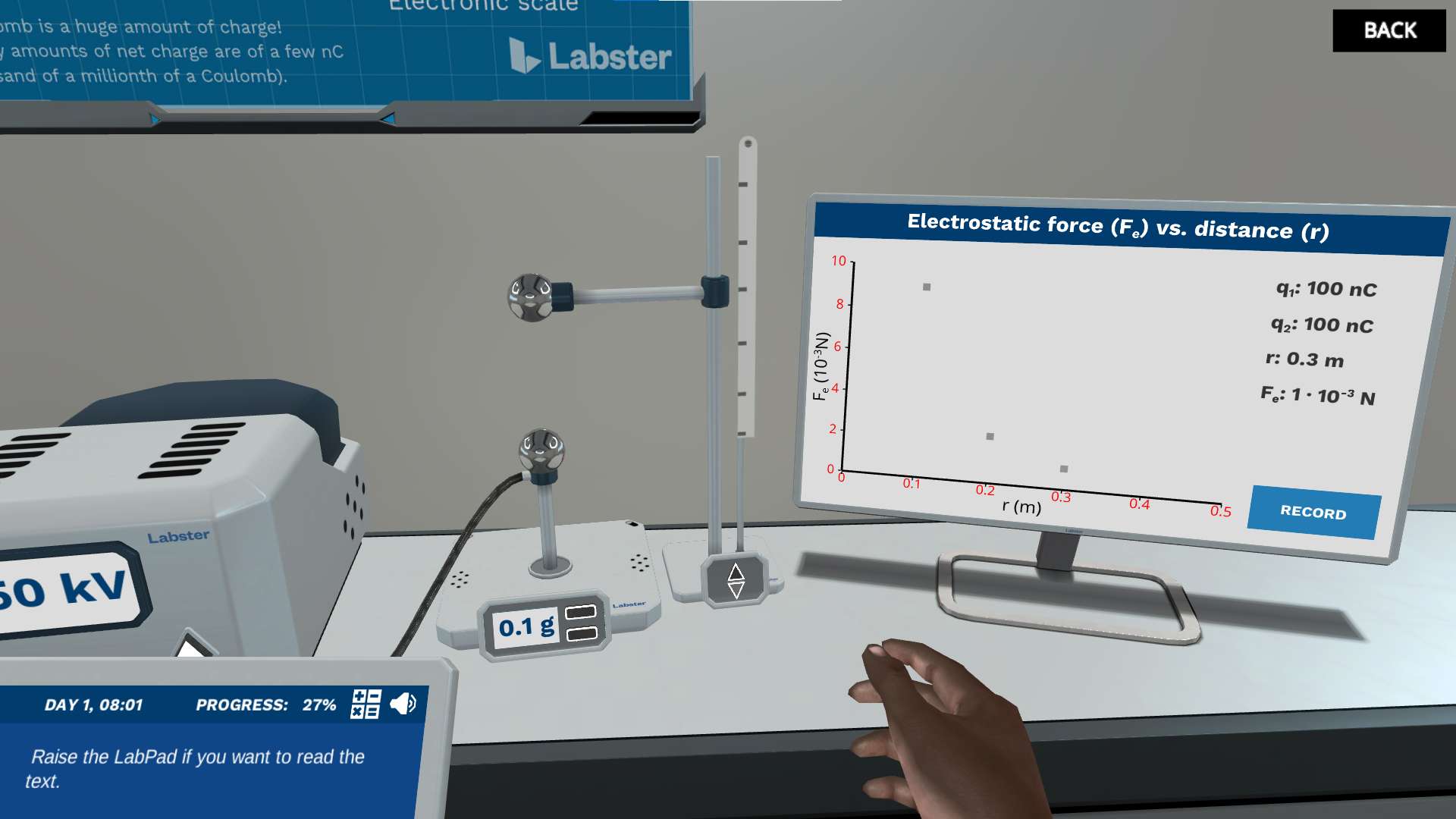Heading 1
Heading 2
Heading 3
Heading 4
Heading 5
Heading 6
Lorem ipsum dolor sit amet, consectetur adipiscing elit, sed do eiusmod tempor incididunt ut labore et dolore magna aliqua. Ut enim ad minim veniam, quis nostrud exercitation ullamco laboris nisi ut aliquip ex ea commodo consequat. Duis aute irure dolor in reprehenderit in voluptate velit esse cillum dolore eu fugiat nulla pariatur.
Block quote
Ordered list
- Item 1
- Item 2
- Item 3
Unordered list
- Item A
- Item B
- Item C
Bold text
Emphasis
Superscript
Subscript
About This Simulation
Experiment with tensions and charges to uncover the secrets of Coulomb's law, the cornerstone of electrostatics.
Learning Objectives
- Identify and describe the electrostatic force between two particles as proportional to the product of their charges and inversely proportional to the separation distance squared
- Apply Coulomb’s law to make predictions about the electrostatic forces between two objects
About This Simulation
Lab Techniques
- Coulomb's law
- Electrostatics
- Inverse-square law
- Magnitude and direction
- Data collection
- Graphs
Related Standards
- HS-PS2-4
Learn More About This Simulation
No wonder Coulomb's law would spark your interest! In this simulation, you will learn how charges interact through the electrostatic force, how different factors influence the strength of that force, and how to determine its direction.
Dr. One's hair-raising new look
Your helpful science assistant, Dr. One, is considering powder coating their case, a process that involves electrostatic forces. Join the lab to learn all about the law that governs those forces: Coulomb's law. Use scientific equipment to measure different values of the electrostatic force and play this sim's minigames to figure out the effect of the charges' signs on its direction.
Charges, distances, and the electrostatic force
Measure, collect, and graph data to figure out the effect of the value of distance and charge on the electrostatic force using realistic scientific equipment, experimenting freely with different values of the parameters. Visualize the impact of the charges' signs on the force through fun graphics and interactive activities. This simulation allows the student to measure the effect of Coulomb's law using a realistic lab setup without the risks electricity entails in real life. Starting from the measurable physical phenomena, the simulation guides the student through increasing stages of mathematization, highlighting the physical meaning behind the algebraic expression of Coulomb's law.
Master Coulomb's law
By the end of the sim, you will have built a qualitative and quantitative understanding of Coulomb's law through the interactive activities in the lab. Do you know what the force between the two charges tells us about Dr. One's new coating?
For Science Programs Providing a Learning Advantage
Boost STEM Pass Rates
Boost Learning with Fun
75% of students show high engagement and improved grades with Labster
Discover Simulations That Match Your Syllabus
Easily bolster your learning objectives with relevant, interactive content
Place Students in the Shoes of Real Scientists
Practice a lab procedure or visualize theory through narrative-driven scenarios


FAQs
Find answers to frequently asked questions.
Heading 1
Heading 2
Heading 3
Heading 4
Heading 5
Heading 6
Lorem ipsum dolor sit amet, consectetur adipiscing elit, sed do eiusmod tempor incididunt ut labore et dolore magna aliqua. Ut enim ad minim veniam, quis nostrud exercitation ullamco laboris nisi ut aliquip ex ea commodo consequat. Duis aute irure dolor in reprehenderit in voluptate velit esse cillum dolore eu fugiat nulla pariatur.
Block quote
Ordered list
- Item 1
- Item 2
- Item 3
Unordered list
- Item A
- Item B
- Item C
Bold text
Emphasis
Superscript
Subscript
A Labster virtual lab is an interactive, multimedia assignment that students access right from their computers. Many Labster virtual labs prepare students for success in college by introducing foundational knowledge using multimedia visualizations that make it easier to understand complex concepts. Other Labster virtual labs prepare learners for careers in STEM labs by giving them realistic practice on lab techniques and procedures.
Labster’s virtual lab simulations are created by scientists and designed to maximize engagement and interactivity. Unlike watching a video or reading a textbook, Labster virtual labs are interactive. To make progress, students must think critically and solve a real-world problem. We believe that learning by doing makes STEM stick.
Yes, Labster is compatible with all major LMS (Learning Management Systems) including Blackboard, Canvas, D2L, Moodle, and many others. Students can access Labster like any other assignment. If your institution does not choose an LMS integration, students will log into Labster’s Course Manager once they have an account created. Your institution will decide which is the best access method.
Labster is available for purchase by instructors, faculty, and administrators at education institutions. Purchasing our starter package, Labster Explorer, can be done using a credit card if you are located in the USA, Canada, or Mexico. If you are outside of North America or are choosing a higher plan, please speak with a Labster sales representative. Compare plans.
Labster supports a wide range of STEM courses at the high school, college, and university level across fields in biology, chemistry, physics, and health sciences. You can identify topics for your courses by searching our Content Catalog.














